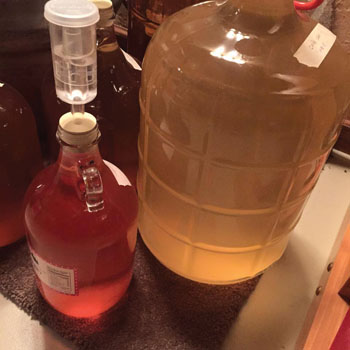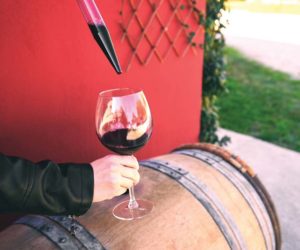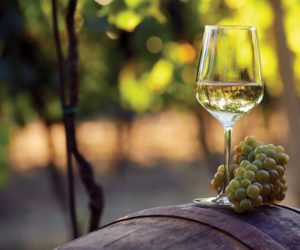Q
I need some help! Both wines in this picture (bottom right of this page) are candy cane wine. The one on the right has turned a different color than the 1⁄2 gallon (2 L) I have for topping off. Could it just be that the dye that was used in making the candy canes has fallen out? This is my First time making candy cane wine so any advice or thoughts are appreciated.
Steve Plaso
New Philadelphia, Ohio
A
Well, well, well. Candy cane wine is one I have never heard of! However, as one of my winemaking professors always said, you can ferment just about anything as long as you can find the right microbe to do it! Candy canes certainly have a sugar source (sucrose), so wine yeast will definitely chew through that sugar and turn it into alcohol. Now whether or not you like the results is up to you . . .
However your question was about color loss. From my experience licking (and not fermenting) them, I seem to remember that most candy canes only have the red color on the outside. Lick the end into a sharp point (with which I loved to poke my sister) and what you’re licking is a white sugar core — you’ve sucked all that red color off. Most candy canes also are colored with food-grade artificial coloring. I’m no food additive expert but it’s no surprise to me that these colorings are not particularly stable. Because of their chemical composition under wine pH (acidity) and fermentation conditions it’s also quite possible these color compounds won’t stay red, or in solution, very long. Wine color compounds change all the time.
My suggestion if you’d like to maintain a little pink color in your candy cane wine is to add about 1–2 ounces of red grape juice concentrate per gallon of wine (7–17 g per L) you are making, before it ferments. This way you’ll introduce some more-stable color compounds into the brew but the “grapey” flavor won’t overpower what I imagine is a minty-fresh flavor profile you’re going for. Or, blend in some red wine before bottling, this gives more control over the desired color. I have to hand it to our creative home winemakers — candy cane wine is a new one for me! Good luck fermenting.
Q
I just opened a bottle from my stock of my homemade Concord wine that I bottled in 1992 and it was very cloudy. I checked others of the same year and they apparently are all the same. I have your Winemaker’s Answer Book, but can’t seem to find an answer to my problem as to how to clear them. I would like to clear and then re-bottle them.
Harry
via email
A
Since 1992 (over 20 years) is quite a long time to store bottled wine. If you go to a supermarket or liquor store, you’ll notice that most red wines currently on the shelf date from 2013, 2012 or at the very oldest 2011. Yes, it’s true that American wine consumers don’t tend to age their wines but in a way it’s because most wines, except for the few truly exceptional pedigree vineyards around the world, peak after five years. If you’ve had good luck aging your Concord wines for that long, and still enjoy them, I applaud you. However, I have to think that your Concord home wine might have been better in the first 2-5 years of its life and not after 23 years in the bottle.
It’s no surprise that after 23 years a homemade wine will throw some sediment or become cloudy, especially Concord, which is naturally high in pectin. This is a natural part of the wine aging process and can get more pronounced as the years go on. As to clearing and re-bottling the wine I do have to ask one question: Do you like how the wine currently tastes? If not, clarifying the visual sediment will do nothing to improve the aroma or flavor. Additionally, clarifying with a fining agent, settling and re-bottling will do nothing but add more oxygen to the wine and will most likely destroy any good characters that might be lingering. My advice: Dump these bottles and make something fresher and less cloudy. Next time try using a pectinase enzyme after pressing (or follow the manufacturer’s instructions) to help remove excess pectin before bottling.
Q
I have a lot of grapes growing in my backyard and I have been making wine for the past three years. I noticed that my grapes started to become dark purple and eventually dry up and fall off. Last year the same thing happened. I don’t know what the reason is. Do you think it could be a problem with the soil or irrigating? The whole June it was raining at least once or twice a week. I’m using composted manure from Home Depot to fertilize it. Can you please help me before all my grapes are lost?
Eduard Lapidus
Brooklyn, New York
A
It sounds to me like you possibly have a heat and/or overexposure problem there with your vines. I’ll share a little personal anecdote with you about a similar situation that I have some experience with in hopes that it relates to your own situation and helps you out.
I have a Malbec grapevine in a pot, which my husband and I recently transplanted when we moved from our old house in downtown Napa, California to a new property off on the west side of town. At the old place, the grapevine used to be in a big 1⁄2 barrel planter that didn’t have a bottom, so roots had the opportunity to reach down into the soil underneath.
When we moved, we dug it up and put it into a large 30-gallon (114 L) pot and put it in our new driveway, which faces due west. This is a very sunny spot but my Malbec vine, which is about three years old, is facing some challenges. Like your vines, the fruit shriveled earlier than expected after ripening on the usual trajectory earlier in the season. See if you recognize any of the same things in your vineyard as happened to my vine:
• Shallow root system: Because of the limited root space in the pot, as opposed to the old bottomless wine barrel, the roots just weren’t able to get enough water or nutrients to support a healthy canopy and the few grape clusters that developed. Solution: Plant in the soil, not in a pot and make sure you don’t have a “hardpan” situation where a hard layer of clay or rock keeps roots from going deep.
• Not enough water-holding capacity in soil: I made the mistake of transferring old, tired garden soil from the old house into the pot as we were in a rush to move. This most likely caused a nutrient deficiency, was not “living soil,” and provided soil with limited water-holding capacity. If you have poor soil you may really have to work in lots of compost over time. Solution: I should’ve added more organic matter to my potting soil to help retain water and provide additional nutrients.
• Insufficient canopy to shade grape clusters and develop healthy fruit: Because of the shallow root system and poor soil, not enough good nutrients were taken up by the vine as it came out of dormancy and budded out leaves. Over time, fewer than normal leaves developed and those that did were smaller than normal. This meant that those few clusters that did develop were at increased risk of sunburn and raisining after they turned purple and the heat really turned up. Solution: Do all you can to take care of and enrich your soil but also leave enough canes and leaves on during the growing season for your winemaking goals and your growing conditions. The last thing you want to do is leaf thin before a massive heat spike.
• Insufficient irrigation: When our driveway gets to be over 100 °F (38 °C) on a regular basis during the summer, it’s just not a healthy situation for a grapevine with limited soil, shallow root system and insufficient canopy. I made it really hard on myself, and on this poor grapevine, to get it enough water every other day to keep it going. Solution: Stressed vines with all of the above issues will just need more water to survive and be healthy. By solving the first three issues I could lessen the amount of water I had to put on the vine. Wherever your vine is planted, it’s important to dribble enough water to keep leaves from wilting. If you see wilting leaves, it’s gotten too dry. You want to water deeply and thoroughly, completely filling the root zone each time you water. For this reason I like “drip irrigation” where you provide a small volume of water over a relatively long period of time. This lets the water penetrate deeply with little runoff. Drip irrigation in relatively deep soils, on mature vines, can be done about once a week but will need to be increased during periods of hot weather.
• Too much hangtime: And last but not least, is it possible that you are just leaving the grapes too long on the vines? Depending on the varietal and the type of wine desired, one can usually plan on harvesting grapes about 35-55 days after veraison (when the grapes turn from green to purple). Solution: Taste your grapes and harvest when Brixes are between 23-25 depending on the type of wine you want to make (rough guidelines). Look at the calendar and the weather and call the pick balancing timing, the forecast, and all the signs of ripeness including color, acid balance, astringency, and flavor.
Growing grapes for wine is not an easy task and I congratulate you on even trying (me, I have one lousy vine in a pot). Take good care of your soil. Make sure you are growing enough canopy to shade the grapes during the hottest part of the day and are dribbling in water regularly over the growing season and especially during those late summer-early fall heat spikes that can happen in many parts of the country.
Q
I have been experimenting with maple sap to produce wine. Rather than adding water to maple syrup I reduced fresh sap to a potential alcohol of 10-12%. As there is very little if any acid present in the sap my pH needed more acid. I added twice the recommended amount of acid blend, and then juiced several lemons. The acid was still too low so I added the rinds in a straining bag to the must. The result was a lemonade containing alcohol. I tried again without the lemons and only the amount of acid blend as stated on the bottle. The result is flavorless other than a hint of lemon from the acid blend and has very little body. I back sweetened with maple syrup attempting to add some flavor but it quickly becomes too sweet yet still lacks flavor.
How can I retain or enhance natural flavors and increase body?
Mark Wyman
Howard Lake, Minnesota
A
Maple sap is a great source of natural sugar and certainly qualifies as home winemaking material. What is less certain, as you have found out, is how much of those subtle maple aromas and flavors will stick around in a finished wine. I’m glad you’re experimenting with adding acid. Like you’ve discovered, maple syrup just doesn’t have enough natural acid on its own to create a
balanced finished product. Acid blends will usually have a combination of malic and tartaric acids, which better mimic a grape’s natural acid profile and will help contribute to a better eventual mouthfeel and refreshing “zing”.
Lemon rinds, especially, (as it seems you’ve discovered) can contribute what is perhaps unwanted lemony aromas and flavors. Don’t forget that what makes a lemon “lemony” is all about that tiny, thin layer of yellow-colored zest on the very outside of the fruit. It’s after all why a martini “with a twist” can taste so citrusy with just a brush of lemon peel. The pith, or the white part underneath the yellow peel, is chock full of bitter and astringent compounds, which you most likely don’t want to get into your finished wine. It’s undoubtedly contributing to those “lemonade” flavors that you describe not wanting.
To improve body and overall mouthfeel profile I suggest replacing about 1⁄2 to 1⁄3 of your sugar source (maple syrup) with a neutral white grape juice concentrate like Thompson Seedless or even Chardonnay. This will provide enhanced natural acid and body components and will also provide better yeast nutrition. If you’re looking to get more natural maple flavor into this project, might I suggest shopping for a little bottle of natural maple flavor online or at your local natural foods store? Add it when your wine is done fermenting (make sure it doesn’t contain any sugar, most do not) and in very small initial doses as some brands are quite strong. This sounds like a great brunch wine with pancakes!






